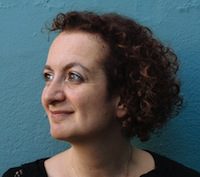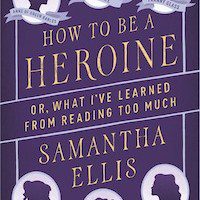Why do we read? Besides entertainment and escape, intellectual stimulation, and exposure to a world beyond our limited experience, one of the most fundamental reasons is to gain a perspective on our own existence. Ever since the novel was invented, women and girls, especially, have sought in its pages inspirational heroines to emulate.
The idea of reading for likeable and relatable characters in fiction has understandably come under fire. When Claire Messud was challenged to defend the “unlikeability” of her protagonist in The Woman Upstairs, she responded, in part, “If you’re reading to find friends, you’re in deep trouble.” More recently, Rebecca Mead has lamented the “scourge of ‘relatability’” and skewered those who judge literature by the unsophisticated yardstick of how much a character reminds us of ourselves. The new book How To Be a Heroine: Or, What I’ve Learned From Reading Too Much, by the British playwright Samantha Ellis, may appear to measure works by a similar yardstick. But it can’t be so easily dismissed.
Her entire life Ellis has read voraciously in search of not exactly friends or people like her, but alternative, aspirational selves—female characters she can look up to and aspire to be. She is not alone. Erin Blakemore was driven by a similar urge when she wrote The Heroine’s Bookshelf: Life Lessons from Jane Austen to Laura Ingalls Wilder, published in 2010, as to some extent was Mead in My Life in Middlemarch, which came out last year. What these books (and countless discussions between women about the books they read) suggest is that for many women the true test of a novel is not so much relatability or likability but admirability.
It makes sense that women have turned to stories for ideas on how to script their own lives, considering that the real-life options for women’s lives historically have been so limited (and remain so in many parts of the world). What makes Ellis’s perspective so compelling is that, as the daughter of Iraqi-Jewish refugees, she grew up in a conservative family and community that expected her, even in the early 1990s, to conform to the conventional mold of womanhood. She felt the pressure of her parents’ expectations, embodied in the piece of her bat mitzvah cake in the freezer they were saving for her wedding day. She realized her upbringing was more like those of the Bennet sisters in Pride and Prejudice than the girls she met at school.

The impetus for How To Be a Heroine began, Ellis tells us, in an argument on the Yorkshire moors with her best friend about who they would rather be: Cathy Earnshaw or Jane Eyre. Ellis had always thought Cathy was her ideal, but her friend convinced her to reconsider Jane. So she embarked on a rereading not only of the Brontë sisters’ classics but all of the books she grew up on, from The Little Mermaid to Cold Comfort Farm. In all, she discusses well over forty books, some more memorable than others. Many of them are well known—Little Women, Anne of Green Gables, Pride and Prejudice, Gone With the Wind, A Room With a View, Franny and Zooey, and The Bell Jar—but many are also either less well known or, frankly, better forgotten—Ballet Shoes by Noel Streatfield, Marjorie Morningstar by Herman Wouk, or The Valley of the Dolls by Jacqueline Susann, to name a few.
While it is often a pleasure to read Ellis’s takes on the books most of us already know and love, it feels rather tedious to hear her lengthy thoughts on unfamiliar books we’ll probably never seek out. In most cases she isn’t even trying to convince us that these are undiscovered gems.
Her reflections on the more universal themes of marriage, love, and life choices in the classics are at the heart of the book. At first many of the readings seem superficial—especially of Little Women, which, in my humble opinion, she misreads. Yet, as the stories and Ellis’s experiences accumulate, she is able to make some compelling insights about the narratives of women’s lives. She does a brilliant, emotional reading of The Bell Jar and What Katy Did, rejecting their apparent message that being a woman means suffering. Ellis has had her share of appalling suffering, in the form of mysterious seizures and blackouts. So when she returns to The Bell Jar, she sees Esther Greenwood—and Plath—anew as survivors, yearning not so much for death as for rebirth.
Like Blakemore and Mead, Ellis does not confine herself to the pages of women’s novels. She takes her search for heroines to biographies of the authors, finding it frustrating that so many relegated their heroines to more conventional plots than they lived themselves. Near the end, as Ellis herself remains single well beyond the age at which her heroines would feel like forlorn spinsters, she asks, “But where are the happy fictional spinsters?” She is tired of feeling like she is “waiting” not “living.”
It is clear that Ellis has spent her life looking for a particular kind of heroine—a feminist one. Unfortunately, she doesn’t quite examine the conundrum that she faces as a woman who wants to be a feminist—which seems to be mean living contentedly without men—but who also wants to be loved and, as she puts it, “happy.” Throughout, she judges female characters for wanting to please men or not developing their independence, but ultimately she has to confess how much pressure the marriage plot has exerted on her own life. “I panic that my life isn’t progressing smoothly toward a happy ending,” she realizes, without examining the irony that the book began with her saying, as a young girl, that she “didn’t want the happy ending my parents wanted for me.”
The book ends with Scheherazade, the storyteller whose own story seemingly has no end. Ellis decides that the “secret of life” is to “keep making choices, keep transforming.” It would have been nice to see Ellis realize that in becoming a story teller herself, she has (re)written her own story, that in the act of telling stories—not only in reading them—women can reinvent the scripts for their lives.
As I finished Ellis’s book, I also wondered to what extent girls and young women today read as she does, for admirability. Many continue to grow up in conservative communities with intense pressure to conform to traditional expectations. Yet in many ways, the pressing need to find admirable heroines has lessened, simply because our contemporary popular culture is suddenly full of them: Elsa and Anna in Frozen, Angelina Jolie’s Maleficent, and Hermione Granger, to name just a few. Perhaps this is why, when I asked my daughter whether she and her friends read for admirability, she said, “I don’t think so.” In addition, many girls today are being raised with much different expectations and models. We take them to events designed to encourage girls to become scientists. They see their mothers earning salaries and advanced degrees. Who knows—we may be on the verge of the first viable female candidate for president.
Nonetheless, as Ellis reminds us, the presence of fictional heroines in our lives still matters. Aren’t we still trying to figure out what kinds of lives women can practically live? There will always be a need for stories that explore the alternatives and give us heroines who help us imagine new ways of living.




